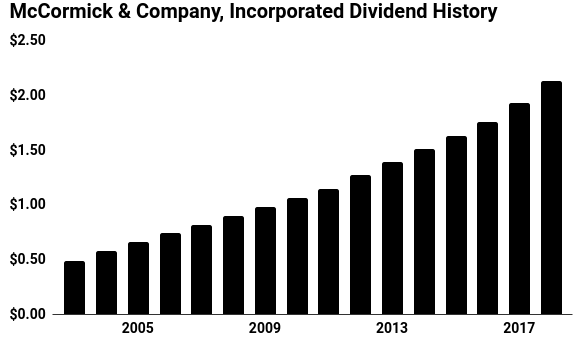A Common-Sense Guide to Spotting Top Dividend Stocks

Spotting Top Dividend Stocks
As I’ve expected for years now, investors have started flocking to dividend stocks.
Traders have fled technology and marijuana shares—the most speculative types of businesses out there. Dividend stocks, in contrast, have held up just fine. While the stock market tanks, names like Merck & Co., Inc. (NYSE:MRK), The Coca-Cola Co (NYSE:KO), and Procter & Gamble Co (NYSE:PG) trade near all-time highs.
Frankly, I’m not surprised.
As I’ve been saying for years, dividend stocks stand head and shoulders above the rest of the market. They’re vastly better.
And if I could pass on just one lesson to you, it would be how to identify these outstanding businesses. It’s the single best way—that I know of, anyway—to build wealth in the stock market.
Let’s use McCormick & Company, Inc. (NYSE:MKC) as an example.
McCormick dominates the spice and seasoning market worldwide. The company’s investment in marketing, built up over decades, distinguishes its products in the grocery aisle. This allows McCormick to charge premium prices over generic brands. And as the value of its brand increases, the company can secure its placement on store shelves.
In other words, McCormick has built a wide competitive moat around its business, protecting it from the competition.
Those are qualitative signs to look for when spotting top dividend stocks. But we also need to dig into the financials of the company. We have to identify the quantitative signs of a remarkable business. And here too, McCormick & Company hints at all of the clues for a great investment.
High return on invested capital (ROIC) serves as one of the hallmarks of top dividend stocks. This metric is calculated by measuring how much profit a business generates and dividing it by how much capital (debt and equity) has been invested in that company.
Poor businesses can earn a high ROIC from year to year. Eventually, though, competition tends to grind those profits into the dust.
If a business can consistently earn exceptional returns, that indicates a real competitive advantage in the marketplace. It also ensures that the business has plenty of cash flow to reward shareholders through dividends and stock buybacks.
Well, McCormick & Company doesn’t just earn high ROIC. It has some of the most consistently high returns of any business I’ve ever seen. Over the past decade, the company has earned $0.16 in annual profit on every dollar of capital invested in the business. At no point over that period did McCormick’s ROIC drop below 15.1%. That’s huge.
Most companies would be over the moon to earn a return of even half that rate. But you don’t often see a business sustain those types of returns over such a long period. I can count on one hand the number of companies that have accomplished a similar feat.
Accomplished management teams signal the second sign of a top dividend stock. Most successful investments come down to a case of “betting on the jockey”—how well executives manage our money.
As analysts, we can measure the performance of executives through a metric called the “one dollar test.” This measure indicates how much value management has created for shareholders on every dollar they’ve invested into the business. In theory, executives should be able to create at least $1.00 in market value on every dollar retained in earnings.
Once again, McCormick has knocked it out of the park. Between 2008 and 2017, the company earned $3.8 billion in net income. From those profits, management paid shareholders $1.7 billion in dividends and plowed $2.1 billion back into the business. Over that period, McCormick added $8.9 billion in market value. So, for every dollar that management retained, management created $4.14 in shareholder value. (Source: “McCormick & Company, Incorporated (MKC),” Yahoo! Finance, last accessed January 15, 2019.)
Finally, wonderful businesses have a long history of dividend growth. I don’t mean to say you should always avoid companies that don’t pay distributions. Dividends, however, serve as a litmus test for great investment ideas. They tell us at a glance whether management is committed to rewarding shareholders.
Here too, McCormick stands out from most other companies. Since 1985, the company has boosted its distribution every single year. Through government shutdowns, stock market crashes, and rising interest rates, management has never hesitated to mail out a little extra cash to loyal investors. That indicates—at least to me, anyway—that management knows who they’re working for: shareholders.

(Source: Ibid.)
So how have things worked out for investors? Well, since we discussed McCormick shares with Automated Income subscribers in March 2015, the stock has delivered a total return, including dividends, of 119%. What’s more, the income stream has increased by 41%.
Those numbers put the company in the same league as hot tech stocks like Apple Inc. (NASDAQ:AAPL), though McCormick accomplished the same feat with a lot less fanfare.
To sum up, the best dividend stocks share a lot of obvious characteristics: great brands, low-cost advantages, irreplaceable assets, etc. But today’s lesson shows you some vital quantitative clues for finding these stocks—and why McCormick & Company is a great example.











